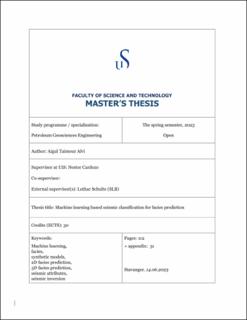| dc.description.abstract | This thesis explores the performance of machine learning (ML) methods for predicting facies from seismic attributes for 2D and 3D datasets. It focuses on building, training, and testing four supervised methods: Logistic Regression, Support Vector Machines, K-Nearest Neighbors, and Random Forest; and one deep learning method: Neural Network with two hidden layers. A realistic synthetic facies model with complex depositional systems, and a synthetic seismic cube from the facies model are used for the comparison of facies prediction performed by the ML approach with the ground-truth facies distribution. This comparison makes it possible to validate the ML models’ prediction based on wells and seismic. In addition, the research evaluates the role of the number of wells and their locations, the impact of seismic data frequency, and the effect of using various seismic attributes. The most important features for facies prediction are seismic inversion and relative acoustic impedance. Instantaneous frequency and envelope have little effect on the accuracy of the ML prediction. Incorporating information about the lateral geometry of the facies in the reservoir also improves the accuracy of the ML prediction. | |
